End-User Perception of Medical Equipment at Five KSA Hospitals
VerifiedAdded on 2019/12/18
|89
|30455
|36
Project
AI Summary
This project investigates the end-user perception of selective medical equipment in five hospitals located in the Eastern Province of Saudi Arabia (KSA). The study, conducted through questionnaires completed by 170 hospital workers, evaluates the factors influencing end-user satisfaction with medical equipment. The research reveals significant issues, including inadequate machine maintenance and user dissatisfaction with the services provided. Key challenges identified include difficulties in operating the equipment and the negative impact of these issues on service quality. The research provides a detailed overview of the hospitals involved (KFMMC, KFUH, KFSH, Dammam Central Hospital, and Al Mowasat Hospital), the types of medical equipment used, and the brands employed. It explores the importance of understanding user perceptions and their impact on healthcare outcomes, the study examines the research objectives, literature review, methodology, data analysis, and findings, offering insights into the areas for improvement within the healthcare sector in KSA. The study also includes an overview of the theoretical and conceptual frameworks. The study concludes with recommendations for improving medical equipment maintenance, user training, and overall service quality to enhance patient care and operational efficiency.
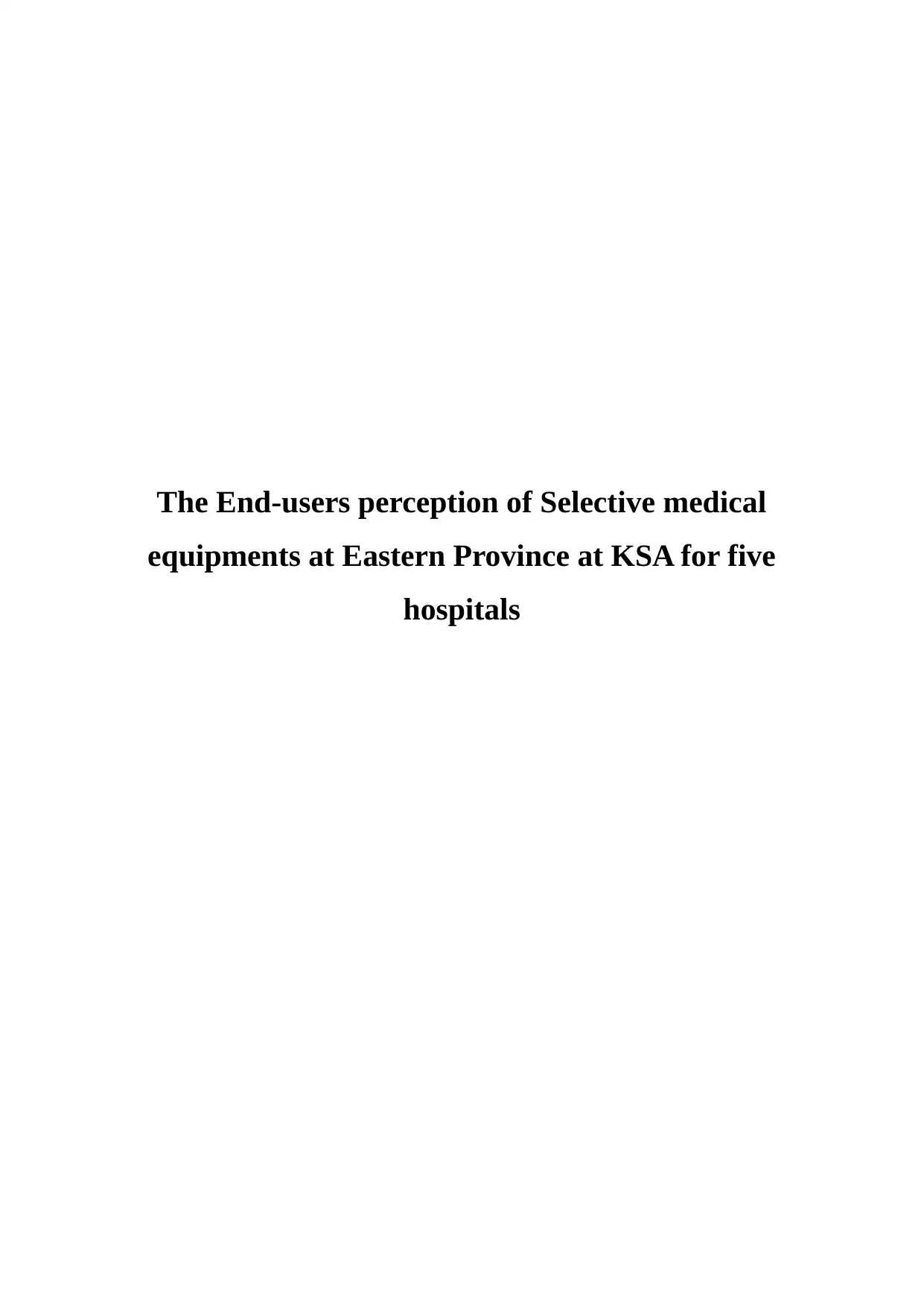
The End-users perception of Selective medical
equipments at Eastern Province at KSA for five
hospitals
equipments at Eastern Province at KSA for five
hospitals
Paraphrase This Document
Need a fresh take? Get an instant paraphrase of this document with our AI Paraphraser

Declaration of Authorship
I......declare that this particular dissertation has been prepared by myself and in my own
words. I confirm that:
This particular work has been wholly done by me
I have just consulted to the others work I have mentioned
Also, I have acknowledged all the main sources from where help has been taken.
I......declare that this particular dissertation has been prepared by myself and in my own
words. I confirm that:
This particular work has been wholly done by me
I have just consulted to the others work I have mentioned
Also, I have acknowledged all the main sources from where help has been taken.
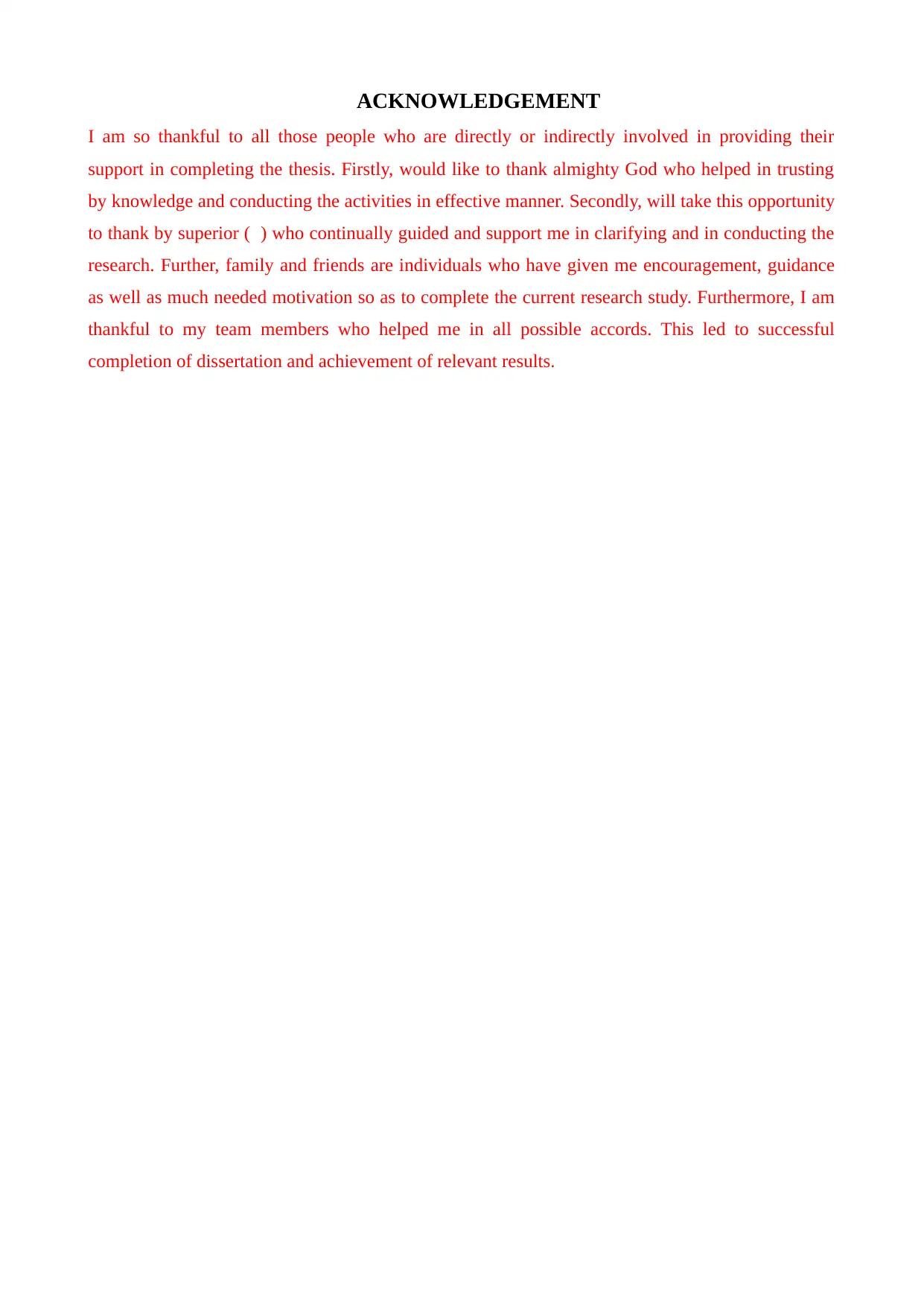
ACKNOWLEDGEMENT
I am so thankful to all those people who are directly or indirectly involved in providing their
support in completing the thesis. Firstly, would like to thank almighty God who helped in trusting
by knowledge and conducting the activities in effective manner. Secondly, will take this opportunity
to thank by superior ( ) who continually guided and support me in clarifying and in conducting the
research. Further, family and friends are individuals who have given me encouragement, guidance
as well as much needed motivation so as to complete the current research study. Furthermore, I am
thankful to my team members who helped me in all possible accords. This led to successful
completion of dissertation and achievement of relevant results.
I am so thankful to all those people who are directly or indirectly involved in providing their
support in completing the thesis. Firstly, would like to thank almighty God who helped in trusting
by knowledge and conducting the activities in effective manner. Secondly, will take this opportunity
to thank by superior ( ) who continually guided and support me in clarifying and in conducting the
research. Further, family and friends are individuals who have given me encouragement, guidance
as well as much needed motivation so as to complete the current research study. Furthermore, I am
thankful to my team members who helped me in all possible accords. This led to successful
completion of dissertation and achievement of relevant results.
⊘ This is a preview!⊘
Do you want full access?
Subscribe today to unlock all pages.

Trusted by 1+ million students worldwide

EXECUTIVE SUMMARY
It could be evaluated from the study that it covers the factors which affect the end users perception
at Eastern Province at KSA for five hospitals. However, through attaining appropriate outcome,
questionnaire was developed and it was filled by 170 workers within five hospitals. Majority of the
hospitals does not maintain their machines and users are not at all satisfied with the type of services
that are get from these machines. Further, hospitals need to maintain the machines that is not done
and due to this, the rate of quality is getting negatively affected. One of the main issues with the
brand that is used by them was difficulty in making use of the machine.
It could be evaluated from the study that it covers the factors which affect the end users perception
at Eastern Province at KSA for five hospitals. However, through attaining appropriate outcome,
questionnaire was developed and it was filled by 170 workers within five hospitals. Majority of the
hospitals does not maintain their machines and users are not at all satisfied with the type of services
that are get from these machines. Further, hospitals need to maintain the machines that is not done
and due to this, the rate of quality is getting negatively affected. One of the main issues with the
brand that is used by them was difficulty in making use of the machine.
Paraphrase This Document
Need a fresh take? Get an instant paraphrase of this document with our AI Paraphraser

Table of Contents
CHAPTER 1 - INTRODUCTION.......................................................................................................1
1.1 Chapter objectives......................................................................................................................1
1.2 Introduction................................................................................................................................1
1.3 Company profile........................................................................................................................2
1.4 Statement of the problem...........................................................................................................3
1.5 Aim of the study.........................................................................................................................3
1.6 Research objectives....................................................................................................................4
1.7 Hypothesis.................................................................................................................................4
1.8 Significant of the study..............................................................................................................4
1.9 Scope and limitation of the study..............................................................................................4
1.10 Expected contribution of the Study.........................................................................................5
1.11 Structure of the Study..............................................................................................................5
1.12 Definition of terms...................................................................................................................7
CHAPTER 2 : LITERATURE REVIEW.............................................................................................8
2.1 Research Objective....................................................................................................................8
2.2 Systematic reviews....................................................................................................................8
2.3 Summary..................................................................................................................................11
2.4 Contribution of the literature review to the project.................................................................18
2.5 Chapter summary.....................................................................................................................18
CHAPTER 3 METHODOLOGY: Summary of the Empirical study.................................................20
3.1 Research Objectives.................................................................................................................20
3.2 Summary and critiquing of the Empirical study......................................................................20
3.3 Highlighting the major factors of the appropriate research framework across studies or
authors............................................................................................................................................21
3.4 The contribution of the literature reviews to the research.......................................................26
3.5 Summary..................................................................................................................................27
CHAPTER 4: PRESENTATION OF DATA EMPIRICAL STUDY..................................................28
4.1 Chapter Objectives...................................................................................................................28
4.2 Theoretical Framework............................................................................................................28
4.3 Conceptual Framework............................................................................................................30
4.4 Operationalization of the independent variable and dependent variables...............................32
CHAPTER 1 - INTRODUCTION.......................................................................................................1
1.1 Chapter objectives......................................................................................................................1
1.2 Introduction................................................................................................................................1
1.3 Company profile........................................................................................................................2
1.4 Statement of the problem...........................................................................................................3
1.5 Aim of the study.........................................................................................................................3
1.6 Research objectives....................................................................................................................4
1.7 Hypothesis.................................................................................................................................4
1.8 Significant of the study..............................................................................................................4
1.9 Scope and limitation of the study..............................................................................................4
1.10 Expected contribution of the Study.........................................................................................5
1.11 Structure of the Study..............................................................................................................5
1.12 Definition of terms...................................................................................................................7
CHAPTER 2 : LITERATURE REVIEW.............................................................................................8
2.1 Research Objective....................................................................................................................8
2.2 Systematic reviews....................................................................................................................8
2.3 Summary..................................................................................................................................11
2.4 Contribution of the literature review to the project.................................................................18
2.5 Chapter summary.....................................................................................................................18
CHAPTER 3 METHODOLOGY: Summary of the Empirical study.................................................20
3.1 Research Objectives.................................................................................................................20
3.2 Summary and critiquing of the Empirical study......................................................................20
3.3 Highlighting the major factors of the appropriate research framework across studies or
authors............................................................................................................................................21
3.4 The contribution of the literature reviews to the research.......................................................26
3.5 Summary..................................................................................................................................27
CHAPTER 4: PRESENTATION OF DATA EMPIRICAL STUDY..................................................28
4.1 Chapter Objectives...................................................................................................................28
4.2 Theoretical Framework............................................................................................................28
4.3 Conceptual Framework............................................................................................................30
4.4 Operationalization of the independent variable and dependent variables...............................32
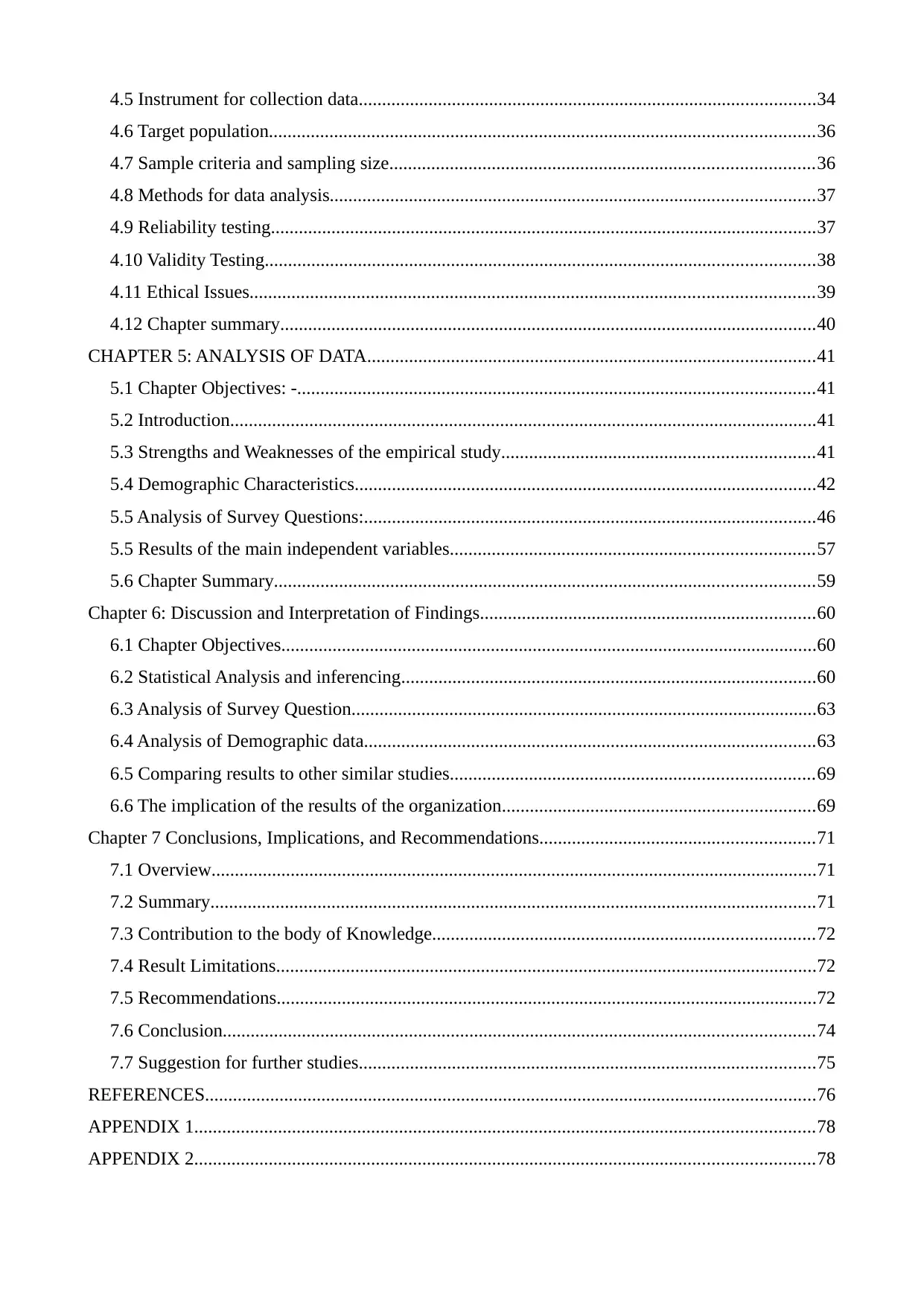
4.5 Instrument for collection data..................................................................................................34
4.6 Target population.....................................................................................................................36
4.7 Sample criteria and sampling size...........................................................................................36
4.8 Methods for data analysis........................................................................................................37
4.9 Reliability testing.....................................................................................................................37
4.10 Validity Testing......................................................................................................................38
4.11 Ethical Issues.........................................................................................................................39
4.12 Chapter summary...................................................................................................................40
CHAPTER 5: ANALYSIS OF DATA................................................................................................41
5.1 Chapter Objectives: -...............................................................................................................41
5.2 Introduction..............................................................................................................................41
5.3 Strengths and Weaknesses of the empirical study...................................................................41
5.4 Demographic Characteristics...................................................................................................42
5.5 Analysis of Survey Questions:.................................................................................................46
5.5 Results of the main independent variables..............................................................................57
5.6 Chapter Summary....................................................................................................................59
Chapter 6: Discussion and Interpretation of Findings........................................................................60
6.1 Chapter Objectives...................................................................................................................60
6.2 Statistical Analysis and inferencing.........................................................................................60
6.3 Analysis of Survey Question....................................................................................................63
6.4 Analysis of Demographic data.................................................................................................63
6.5 Comparing results to other similar studies..............................................................................69
6.6 The implication of the results of the organization...................................................................69
Chapter 7 Conclusions, Implications, and Recommendations...........................................................71
7.1 Overview..................................................................................................................................71
7.2 Summary..................................................................................................................................71
7.3 Contribution to the body of Knowledge..................................................................................72
7.4 Result Limitations....................................................................................................................72
7.5 Recommendations....................................................................................................................72
7.6 Conclusion...............................................................................................................................74
7.7 Suggestion for further studies..................................................................................................75
REFERENCES...................................................................................................................................76
APPENDIX 1.....................................................................................................................................78
APPENDIX 2.....................................................................................................................................78
4.6 Target population.....................................................................................................................36
4.7 Sample criteria and sampling size...........................................................................................36
4.8 Methods for data analysis........................................................................................................37
4.9 Reliability testing.....................................................................................................................37
4.10 Validity Testing......................................................................................................................38
4.11 Ethical Issues.........................................................................................................................39
4.12 Chapter summary...................................................................................................................40
CHAPTER 5: ANALYSIS OF DATA................................................................................................41
5.1 Chapter Objectives: -...............................................................................................................41
5.2 Introduction..............................................................................................................................41
5.3 Strengths and Weaknesses of the empirical study...................................................................41
5.4 Demographic Characteristics...................................................................................................42
5.5 Analysis of Survey Questions:.................................................................................................46
5.5 Results of the main independent variables..............................................................................57
5.6 Chapter Summary....................................................................................................................59
Chapter 6: Discussion and Interpretation of Findings........................................................................60
6.1 Chapter Objectives...................................................................................................................60
6.2 Statistical Analysis and inferencing.........................................................................................60
6.3 Analysis of Survey Question....................................................................................................63
6.4 Analysis of Demographic data.................................................................................................63
6.5 Comparing results to other similar studies..............................................................................69
6.6 The implication of the results of the organization...................................................................69
Chapter 7 Conclusions, Implications, and Recommendations...........................................................71
7.1 Overview..................................................................................................................................71
7.2 Summary..................................................................................................................................71
7.3 Contribution to the body of Knowledge..................................................................................72
7.4 Result Limitations....................................................................................................................72
7.5 Recommendations....................................................................................................................72
7.6 Conclusion...............................................................................................................................74
7.7 Suggestion for further studies..................................................................................................75
REFERENCES...................................................................................................................................76
APPENDIX 1.....................................................................................................................................78
APPENDIX 2.....................................................................................................................................78
⊘ This is a preview!⊘
Do you want full access?
Subscribe today to unlock all pages.

Trusted by 1+ million students worldwide

Questionnaire.................................................................................................................................78
Paraphrase This Document
Need a fresh take? Get an instant paraphrase of this document with our AI Paraphraser

List of Tables
Table 1: Dependent Variables.............................................................................................................33
Table 2: Short keys.............................................................................................................................78
Table 3: Dependent variables.............................................................................................................80
Table 1: Dependent Variables.............................................................................................................33
Table 2: Short keys.............................................................................................................................78
Table 3: Dependent variables.............................................................................................................80
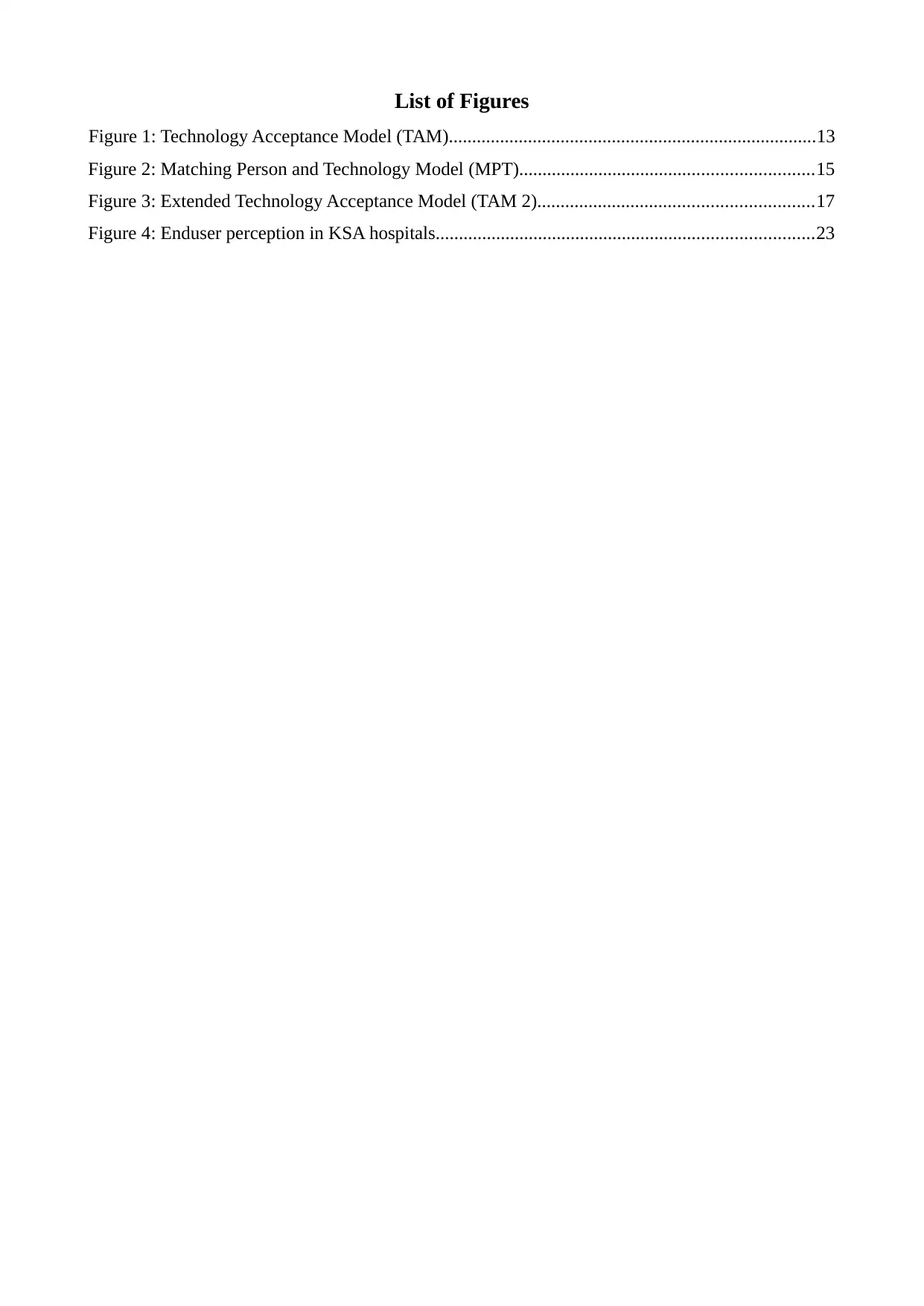
List of Figures
Figure 1: Technology Acceptance Model (TAM)...............................................................................13
Figure 2: Matching Person and Technology Model (MPT)...............................................................15
Figure 3: Extended Technology Acceptance Model (TAM 2)...........................................................17
Figure 4: Enduser perception in KSA hospitals.................................................................................23
Figure 1: Technology Acceptance Model (TAM)...............................................................................13
Figure 2: Matching Person and Technology Model (MPT)...............................................................15
Figure 3: Extended Technology Acceptance Model (TAM 2)...........................................................17
Figure 4: Enduser perception in KSA hospitals.................................................................................23
⊘ This is a preview!⊘
Do you want full access?
Subscribe today to unlock all pages.

Trusted by 1+ million students worldwide
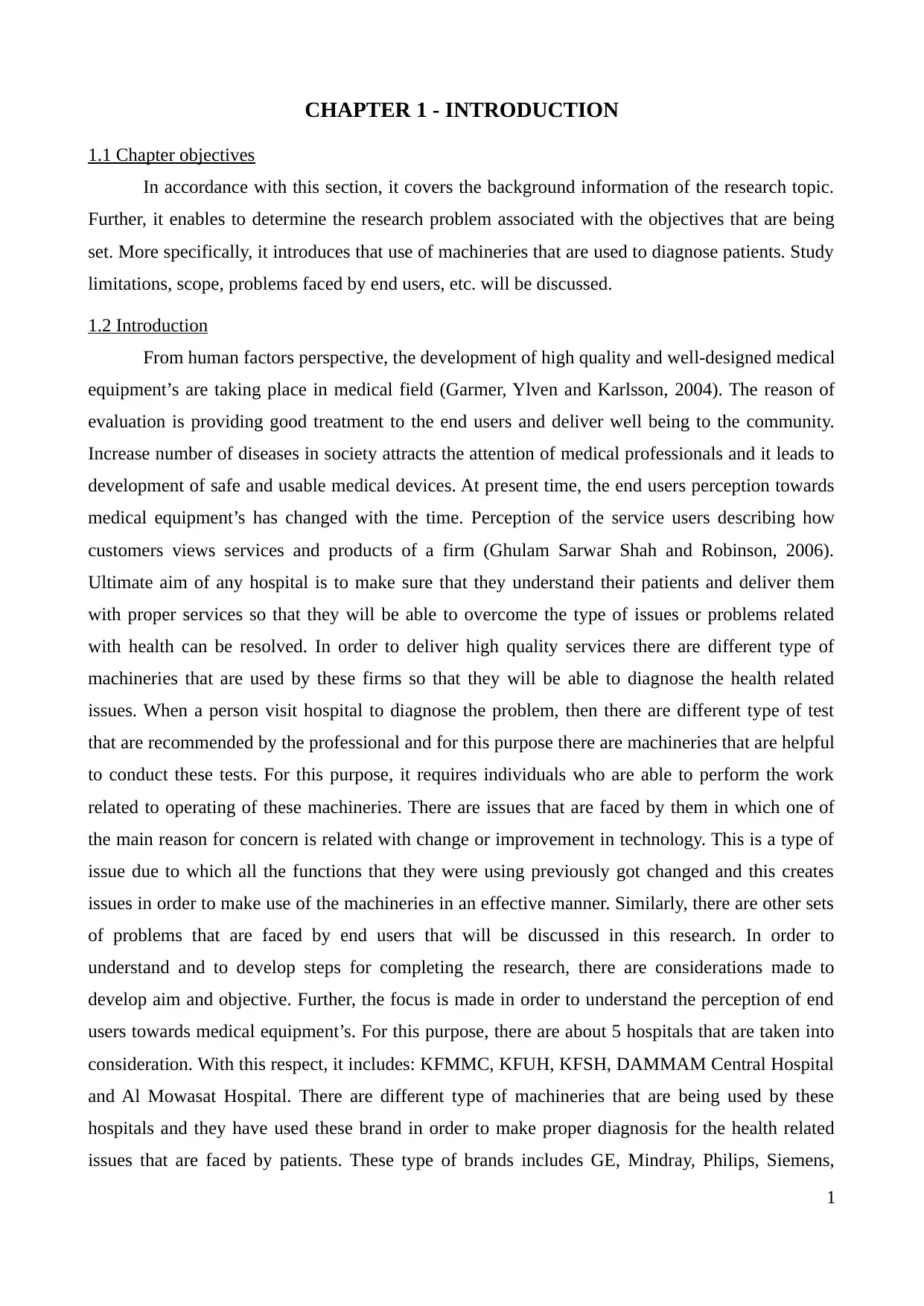
CHAPTER 1 - INTRODUCTION
1.1 Chapter objectives
In accordance with this section, it covers the background information of the research topic.
Further, it enables to determine the research problem associated with the objectives that are being
set. More specifically, it introduces that use of machineries that are used to diagnose patients. Study
limitations, scope, problems faced by end users, etc. will be discussed.
1.2 Introduction
From human factors perspective, the development of high quality and well-designed medical
equipment’s are taking place in medical field (Garmer, Ylven and Karlsson, 2004). The reason of
evaluation is providing good treatment to the end users and deliver well being to the community.
Increase number of diseases in society attracts the attention of medical professionals and it leads to
development of safe and usable medical devices. At present time, the end users perception towards
medical equipment’s has changed with the time. Perception of the service users describing how
customers views services and products of a firm (Ghulam Sarwar Shah and Robinson, 2006).
Ultimate aim of any hospital is to make sure that they understand their patients and deliver them
with proper services so that they will be able to overcome the type of issues or problems related
with health can be resolved. In order to deliver high quality services there are different type of
machineries that are used by these firms so that they will be able to diagnose the health related
issues. When a person visit hospital to diagnose the problem, then there are different type of test
that are recommended by the professional and for this purpose there are machineries that are helpful
to conduct these tests. For this purpose, it requires individuals who are able to perform the work
related to operating of these machineries. There are issues that are faced by them in which one of
the main reason for concern is related with change or improvement in technology. This is a type of
issue due to which all the functions that they were using previously got changed and this creates
issues in order to make use of the machineries in an effective manner. Similarly, there are other sets
of problems that are faced by end users that will be discussed in this research. In order to
understand and to develop steps for completing the research, there are considerations made to
develop aim and objective. Further, the focus is made in order to understand the perception of end
users towards medical equipment’s. For this purpose, there are about 5 hospitals that are taken into
consideration. With this respect, it includes: KFMMC, KFUH, KFSH, DAMMAM Central Hospital
and Al Mowasat Hospital. There are different type of machineries that are being used by these
hospitals and they have used these brand in order to make proper diagnosis for the health related
issues that are faced by patients. These type of brands includes GE, Mindray, Philips, Siemens,
1
1.1 Chapter objectives
In accordance with this section, it covers the background information of the research topic.
Further, it enables to determine the research problem associated with the objectives that are being
set. More specifically, it introduces that use of machineries that are used to diagnose patients. Study
limitations, scope, problems faced by end users, etc. will be discussed.
1.2 Introduction
From human factors perspective, the development of high quality and well-designed medical
equipment’s are taking place in medical field (Garmer, Ylven and Karlsson, 2004). The reason of
evaluation is providing good treatment to the end users and deliver well being to the community.
Increase number of diseases in society attracts the attention of medical professionals and it leads to
development of safe and usable medical devices. At present time, the end users perception towards
medical equipment’s has changed with the time. Perception of the service users describing how
customers views services and products of a firm (Ghulam Sarwar Shah and Robinson, 2006).
Ultimate aim of any hospital is to make sure that they understand their patients and deliver them
with proper services so that they will be able to overcome the type of issues or problems related
with health can be resolved. In order to deliver high quality services there are different type of
machineries that are used by these firms so that they will be able to diagnose the health related
issues. When a person visit hospital to diagnose the problem, then there are different type of test
that are recommended by the professional and for this purpose there are machineries that are helpful
to conduct these tests. For this purpose, it requires individuals who are able to perform the work
related to operating of these machineries. There are issues that are faced by them in which one of
the main reason for concern is related with change or improvement in technology. This is a type of
issue due to which all the functions that they were using previously got changed and this creates
issues in order to make use of the machineries in an effective manner. Similarly, there are other sets
of problems that are faced by end users that will be discussed in this research. In order to
understand and to develop steps for completing the research, there are considerations made to
develop aim and objective. Further, the focus is made in order to understand the perception of end
users towards medical equipment’s. For this purpose, there are about 5 hospitals that are taken into
consideration. With this respect, it includes: KFMMC, KFUH, KFSH, DAMMAM Central Hospital
and Al Mowasat Hospital. There are different type of machineries that are being used by these
hospitals and they have used these brand in order to make proper diagnosis for the health related
issues that are faced by patients. These type of brands includes GE, Mindray, Philips, Siemens,
1
Paraphrase This Document
Need a fresh take? Get an instant paraphrase of this document with our AI Paraphraser

Covidien, etc. All the hospitals make sure that they understand the requirements of patients and
deliver them with high quality services so that they are able to deliver adequate care.
Conceptualization of end users influences their behaviour and it ultimately affects profitably of care
organizations. In Eastern Province at Kingdom of Saudi Arabia (KSA), hospitals are using different
medical equipment’s to diagnosis of diseases and provide care according to it.
1.3 Company profile
As stated above, there are five different type of hospitals that are included in this research
among which these are helpful enough to make sure that current research can be achieved. All these
hospitals are located at Saudi Arabia and their company profile of these 5 hospitals are as follows:
KFMMC: King Fahd Military Medical Complex is one of the modern type of hospitals.
There have all different type of medical equipment’s that are helpful enough to cover all the
diseases for which diagnosis is required. Further, it consists of different type of departments like
Speciality clinics, vascular surgery, kidney transplants, Nephology, etc. Further, there are facility
like helicopter services in which at the type of emergency transfer is possible. More specifically, it
is located at Dhahran city and it consists of all the requirement of the patients. Main aim of the
hospital is to deliver high quality health services to individuals who have physical issues and
specially people injured during war. Further, they conduct health related education programmes in
order to develop understanding of people related to diseases.
KFUH: King Fahd University Hospital, it is located at Khobar. This hospital was founded in
the year 1981. One of the main purpose of this firm to provide students with proper training so that
they will be able to deliver patients with high quality services. There are conditions in which it is
identified that in medical practise there are different type of mistakes that are made by practitioners.
In order to eliminate it with high extent, this is a type of practise that is made by this firm with the
help of which they aim at eliminating the issues or problems that are faced by practitioners. Further,
they have 440 beds and 4 floor building. Each of the flood works for different type of patients and
this hospital was established to deliver three different type of services which are: Curative services,
researches and teaching services.
KFSH: King Fahad Specialist Hospital Dammam is considered to be one of the most
important project in relation with health. This is a new hospitals and still it has focused on
developing strong impact over others and raising their performance. This is done by maintaining
their quality of services and delivering individuals to overcome their health related issues. Main aim
of this firm is to make sure that they deliver patients with high quality services and in supporting
them to overcome the issues. Further, they operate their business with an aim to be one of the most
2
deliver them with high quality services so that they are able to deliver adequate care.
Conceptualization of end users influences their behaviour and it ultimately affects profitably of care
organizations. In Eastern Province at Kingdom of Saudi Arabia (KSA), hospitals are using different
medical equipment’s to diagnosis of diseases and provide care according to it.
1.3 Company profile
As stated above, there are five different type of hospitals that are included in this research
among which these are helpful enough to make sure that current research can be achieved. All these
hospitals are located at Saudi Arabia and their company profile of these 5 hospitals are as follows:
KFMMC: King Fahd Military Medical Complex is one of the modern type of hospitals.
There have all different type of medical equipment’s that are helpful enough to cover all the
diseases for which diagnosis is required. Further, it consists of different type of departments like
Speciality clinics, vascular surgery, kidney transplants, Nephology, etc. Further, there are facility
like helicopter services in which at the type of emergency transfer is possible. More specifically, it
is located at Dhahran city and it consists of all the requirement of the patients. Main aim of the
hospital is to deliver high quality health services to individuals who have physical issues and
specially people injured during war. Further, they conduct health related education programmes in
order to develop understanding of people related to diseases.
KFUH: King Fahd University Hospital, it is located at Khobar. This hospital was founded in
the year 1981. One of the main purpose of this firm to provide students with proper training so that
they will be able to deliver patients with high quality services. There are conditions in which it is
identified that in medical practise there are different type of mistakes that are made by practitioners.
In order to eliminate it with high extent, this is a type of practise that is made by this firm with the
help of which they aim at eliminating the issues or problems that are faced by practitioners. Further,
they have 440 beds and 4 floor building. Each of the flood works for different type of patients and
this hospital was established to deliver three different type of services which are: Curative services,
researches and teaching services.
KFSH: King Fahad Specialist Hospital Dammam is considered to be one of the most
important project in relation with health. This is a new hospitals and still it has focused on
developing strong impact over others and raising their performance. This is done by maintaining
their quality of services and delivering individuals to overcome their health related issues. Main aim
of this firm is to make sure that they deliver patients with high quality services and in supporting
them to overcome the issues. Further, they operate their business with an aim to be one of the most
2
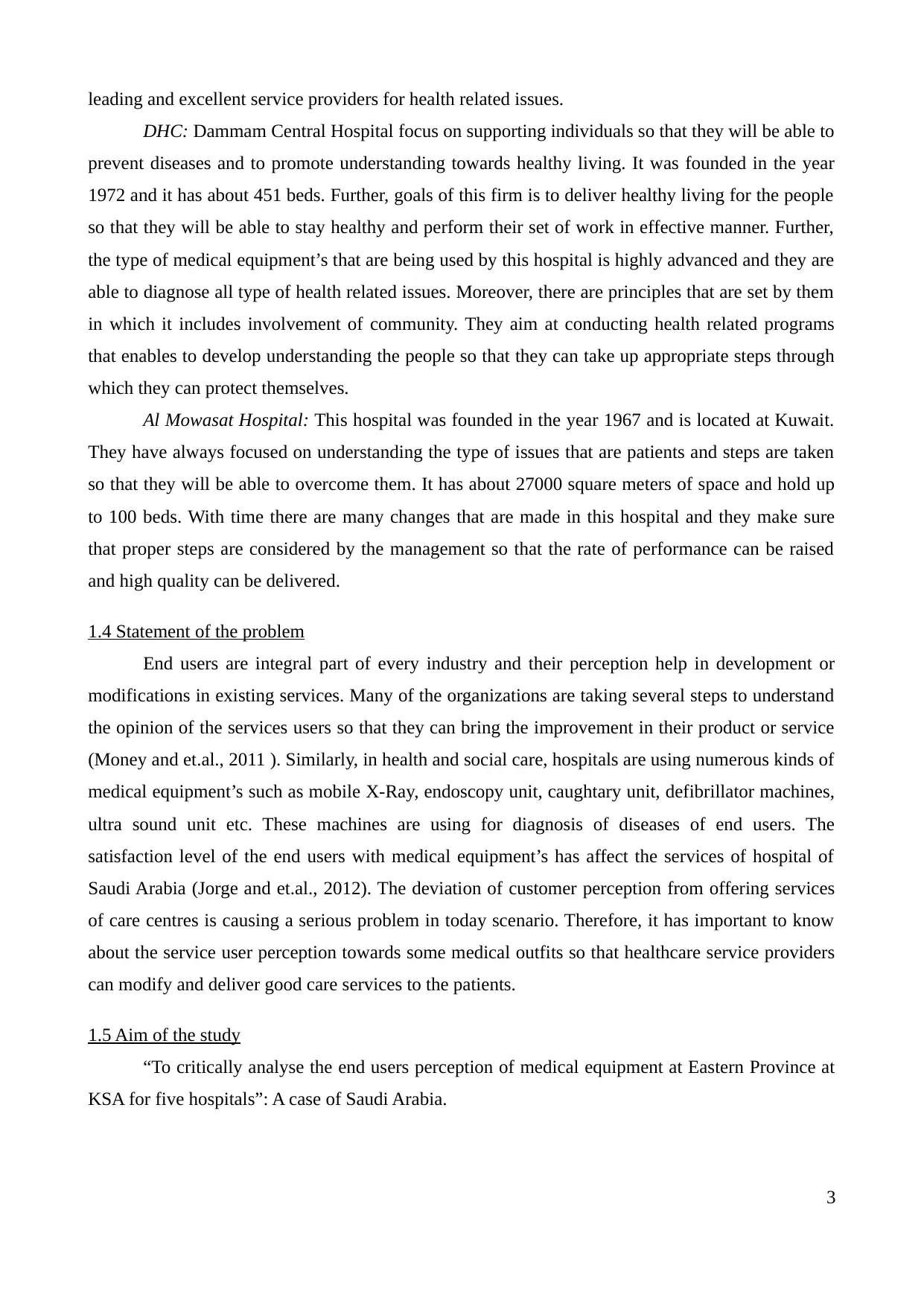
leading and excellent service providers for health related issues.
DHC: Dammam Central Hospital focus on supporting individuals so that they will be able to
prevent diseases and to promote understanding towards healthy living. It was founded in the year
1972 and it has about 451 beds. Further, goals of this firm is to deliver healthy living for the people
so that they will be able to stay healthy and perform their set of work in effective manner. Further,
the type of medical equipment’s that are being used by this hospital is highly advanced and they are
able to diagnose all type of health related issues. Moreover, there are principles that are set by them
in which it includes involvement of community. They aim at conducting health related programs
that enables to develop understanding the people so that they can take up appropriate steps through
which they can protect themselves.
Al Mowasat Hospital: This hospital was founded in the year 1967 and is located at Kuwait.
They have always focused on understanding the type of issues that are patients and steps are taken
so that they will be able to overcome them. It has about 27000 square meters of space and hold up
to 100 beds. With time there are many changes that are made in this hospital and they make sure
that proper steps are considered by the management so that the rate of performance can be raised
and high quality can be delivered.
1.4 Statement of the problem
End users are integral part of every industry and their perception help in development or
modifications in existing services. Many of the organizations are taking several steps to understand
the opinion of the services users so that they can bring the improvement in their product or service
(Money and et.al., 2011 ). Similarly, in health and social care, hospitals are using numerous kinds of
medical equipment’s such as mobile X-Ray, endoscopy unit, caughtary unit, defibrillator machines,
ultra sound unit etc. These machines are using for diagnosis of diseases of end users. The
satisfaction level of the end users with medical equipment’s has affect the services of hospital of
Saudi Arabia (Jorge and et.al., 2012). The deviation of customer perception from offering services
of care centres is causing a serious problem in today scenario. Therefore, it has important to know
about the service user perception towards some medical outfits so that healthcare service providers
can modify and deliver good care services to the patients.
1.5 Aim of the study
“To critically analyse the end users perception of medical equipment at Eastern Province at
KSA for five hospitals”: A case of Saudi Arabia.
3
DHC: Dammam Central Hospital focus on supporting individuals so that they will be able to
prevent diseases and to promote understanding towards healthy living. It was founded in the year
1972 and it has about 451 beds. Further, goals of this firm is to deliver healthy living for the people
so that they will be able to stay healthy and perform their set of work in effective manner. Further,
the type of medical equipment’s that are being used by this hospital is highly advanced and they are
able to diagnose all type of health related issues. Moreover, there are principles that are set by them
in which it includes involvement of community. They aim at conducting health related programs
that enables to develop understanding the people so that they can take up appropriate steps through
which they can protect themselves.
Al Mowasat Hospital: This hospital was founded in the year 1967 and is located at Kuwait.
They have always focused on understanding the type of issues that are patients and steps are taken
so that they will be able to overcome them. It has about 27000 square meters of space and hold up
to 100 beds. With time there are many changes that are made in this hospital and they make sure
that proper steps are considered by the management so that the rate of performance can be raised
and high quality can be delivered.
1.4 Statement of the problem
End users are integral part of every industry and their perception help in development or
modifications in existing services. Many of the organizations are taking several steps to understand
the opinion of the services users so that they can bring the improvement in their product or service
(Money and et.al., 2011 ). Similarly, in health and social care, hospitals are using numerous kinds of
medical equipment’s such as mobile X-Ray, endoscopy unit, caughtary unit, defibrillator machines,
ultra sound unit etc. These machines are using for diagnosis of diseases of end users. The
satisfaction level of the end users with medical equipment’s has affect the services of hospital of
Saudi Arabia (Jorge and et.al., 2012). The deviation of customer perception from offering services
of care centres is causing a serious problem in today scenario. Therefore, it has important to know
about the service user perception towards some medical outfits so that healthcare service providers
can modify and deliver good care services to the patients.
1.5 Aim of the study
“To critically analyse the end users perception of medical equipment at Eastern Province at
KSA for five hospitals”: A case of Saudi Arabia.
3
⊘ This is a preview!⊘
Do you want full access?
Subscribe today to unlock all pages.

Trusted by 1+ million students worldwide
1 out of 89